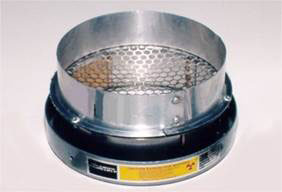Backgrounder on Polonium-210
Printable Version
On this page:
Polonium-210 is a radioactive isotope that occurs in small amounts in nature and can be made in a nuclear reactor. It has limited uses, mainly in static eliminators. Polonium occasionally makes the news because of its use as a poison. Polonium was blamed for the Nov. 23, 2006, death in London of the Russian Alexander Litvinenko. It has also been mentioned as a possible cause of Yassar Arafat’s death.
Polonium was discovered by Marie Curie in 1898; she later named it for her homeland of Poland. Though rare, it is found in tobacco, and in the soil and air. For industrial purposes, it is produced in milligram amounts in nuclear reactors. Only about 100 grams (a little more than 3 ounces) is believed to be produced worldwide each year. Licensed distributors import a very small amount of polonium-210 into the U.S. each year.
Potential Hazards
Polonium-210 emits alpha radiation, which cannot penetrate paper or skin, so external exposure does not pose a health risk. It decays quickly, losing half its radiation in 138 days (its half-life). The radioactivity decays away in about two-and-a-half years. In its most common form, most polonium-210 would likely pass through the system without being absorbed.
Pure polonium-210 must be handled very carefully. If swallowed or inhaled, this form can be fatal in very small amounts. Once absorbed into the body it can be many times more toxic than cyanide. The alpha radiation can rapidly destroy major organs, DNA and the immune system.
Industrial Uses
 |
| Vent-type static eliminator |
 |
|
Bar-type static eliminator
|
Polonium-210 is used in manufacturing in devices that eliminate static. These devices are designed to meet tough NRC standards and pose no threat to public health or safety. The isotope is combined with silver or other metals in a foil mounted inside a protective cage. The design must be approved by the NRC or a state agency. The design and construction make it highly unlikely someone could ingest the radioactive source during normal operation.
Most static elimination devices used in industry are regulated by the NRC as “generally licensed devices.” This means that manufacturers and distributors are licensed by the NRC or state regulatory agencies. Customers who purchase the devices become “general licensees” and must comply with NRC or state regulations regarding their safe storage, operation and disposal.
Small polonium-210 sources can also be used to check or calibrate instruments. These sources have 0.1 microcurie of radioactivity—an extremely small amount that exempts them from needing an NRC license.
Anyone who has an exempt quantity is expected to handle the source using appropriate radiation safety precautions and not attempt to remove the radioactive material. The safety measures are explained in a brochure provided with the source.
Polonium-210 as a poison
The chance of someone getting hold of a lethal dose of polonium-210 is very small. Both the form and amount of radiation in exempt sources mean they would pose no health problem if ingested. It would take tens of thousands of these sources to make a fatal dose. It would be extremely difficult—requiring sophisticated lab work—to extract the polonium-210 and render it in a form that could be used to harm someone. It would also be hazardous and expensive and would violate NRC regulations.
April 2024
Page Last Reviewed/Updated Thursday, April 04, 2024